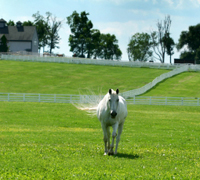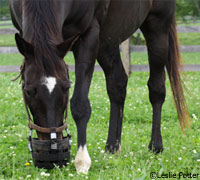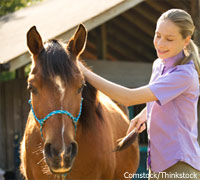 |
| In general, horses are healthier when they are allowed to be outside as much as possible. Photo: iStockPhoto |
Your horse is your pride and joy, your companion, and an investment. Keeping him happy and healthy year-round is likely one of your top concerns, however, with the plethora of preventative health strategies out there, coupled with seasonal health threats like laminitis, suddenly general equine health care doesn’t seem so general anymore! Here are some tips to help you keep your horse fit and well throughout the year.
Your horse’s living conditions have perhaps the most influence over his general health and well-being. A primary rule of thumb is to keep your horse outside as much as possible. The fresh air helps decrease respiratory problems such as recurrent airway obstruction, (RAO) also known as heaves. Pasture-kept horses also have the benefit of increased exercise opportunities and natural environmental enrichment, which decreases boredom and the development of stereotypic behavioral patterns such as cribbing and stall weaving.
Of course, access to pasture is not always available to everyone. If your horse is stabled, you can make his indoor environment as comfortable and healthy as possible with a few simple practices. First, don’t store hay in the same area as your horse. Not only is hay in the barn a fire hazard, but it can also grossly increase the amount of dust and mold in the air, key factors contributing to equine respiratory illness. Second, keep the stalls as clean as possible. The buildup of ammonia fumes from urine-saturated bedding is extremely caustic to the delicate lining of the respiratory tract. Thirdly, keep out wildlife as best as possible. Opossums are particularly important to abolish from the barn, as they are the primary host for the parasite Sarcocystis neurona, the causative agent of the degenerative neurological disease equine protozoal myeloencephalitis (EPM).
 |
| Lush, spring grass can lead to health problems such as laminitis. A grazing muzzle is a way to reduce grass intake without limiting turnout time. Photo: Leslie Potter |
In spring, it is paramount to monitor the lushness of the pasture for prevention of laminitis, commonly called founder. This debilitating, painful, and sometimes life-threatening metabolic derangement that causes rotation of the coffin bone in the foot has a multitude of complex causes, but consumption of too much carbohydrate-rich spring grass is one of the most common. Depending on your geographic location, autumn rains can result a second regrowth of lush grass. Pasture management such as strip grazing, use of a turnout pen, or employing grazing muzzles is a necessity when dealing with rich pasture.
In the winter, freezing temperatures make it imperative to check water troughs and buckets at least twice daily to break up any ice. Water heaters can be a great help as well. Many horses seem to drink less in the winter and can be more prone to impaction colic due to improper hydration. The best way to prevent this is to provide a constant source of clean, warm water in the winter.
Diet
Ensuring your horse’s diet fits his lifestyle is key to proper weight control. Keep in mind that today’s horses do not need much, if any, grain unless they are growing, sick, old, lactating or pregnant, or used in intense competition.
An entire range of disorders can afflict overweight horses. Laminitis is more common in the overweight horse, as is insulin resistance and equine metabolic syndrome. Overweight horses may also experience more lameness issues due to osteoarthritis because of the extra weight-bearing demand on their joints. Discuss with your veterinarian how to best meet your horse’s dietary needs.
Annual Physical Exams
Many horse owners look at a yearly vet visit as merely a way for their horse to receive his annual vaccines, but make the most out of this visit. Ask your vet to give your horse a full physical exam. Older horses may benefit from annual blood work to help catch problems before they become clinically obvious.
An annual vet visit is also the time to discuss your horse’s specific vaccine and deworming programs. Not all horses require the same vaccines and antiparasitic regime. Discuss with your vet the vaccines the American Association of Equine Practitioners recommends as core and secondary to develop a program that fits your horse’s particular situation.
Do What You Do Best
The most important aspect of your horse’s health is you. As a horse owner, you are a champion for his health, so continue to do what you do best: spend time with your horse.
 |
| By grooming your horse every day, you’ll get to know what is normal for him, both physically and behaviorally. Photo: Comstock/Thinkstock |
Daily grooming not only helps form a bond between you and your horse, but it also allows you to catch any bumps, superficial wounds and any other skin issues, such as scratches or rain rot. Many of these conditions are easily treated if found early.
Interacting with your horse on a daily basis also lets you monitor his mood. Knowing your horse’s normal vital signs and the basic symptoms of serious medical conditions helps you to spot things quickly and take action. Colic can have a host of different signs, including restlessness, loss of appetite, playing in the water trough, looking at the flank, repeatedly lying down and getting up, and lack of manure production. A laminitic horse is often described as “walking on eggshells,” leaning back on his heels and having difficulty with turns as a result of his painful feet. Monitoring for these signs increases the overall effectiveness of your horse’s preventative health care program.
For many health problems, prevention is key. Consciously implementing a wellness program for your horse that involves evaluating his environment, monitoring his diet, and scheduling regular veterinary visits will help keep your equine companion happy and healthy throughout the year.





Great article.
Sweet!